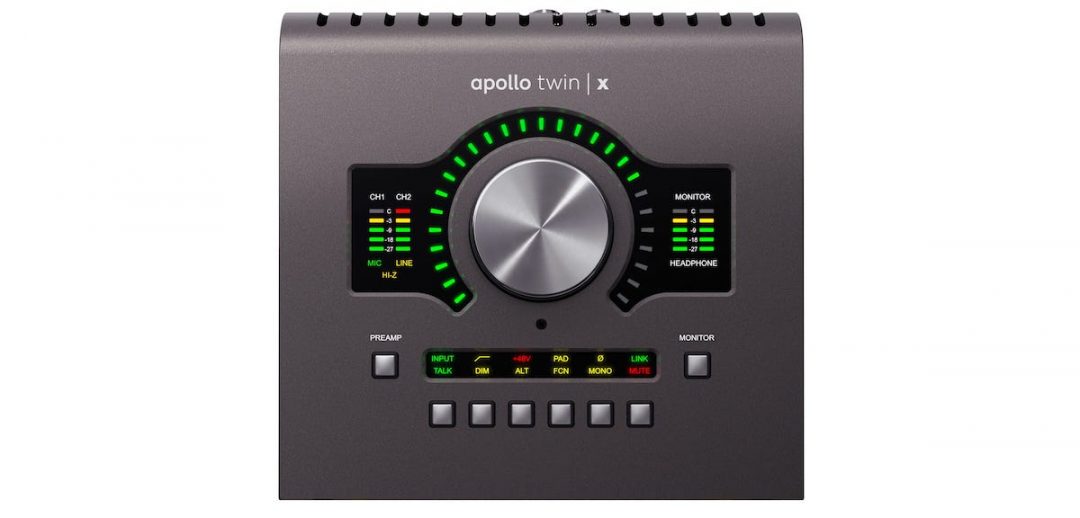Universal Audio is one of the most famous names in all of recording. Founded by Bill Putnam in 1958, the company has been at the forefront of technological advances for more than 60 years. If you’re thinking about adding a Universal Audio interface to your setup, you may be asking yourself the differences between the Apollo Twin X vs MkII.
Universal Audio Interfaces: Apollo Twin X vs MkII
UA is nothing short of an icon in recording technology. Bill Putnam was one of the greatest innovators the industry has ever known. His entrepreneurial spirit produced the ubiquitous 1176 and LA-2A compressors, as well as the 610 tube console. He helped pioneer stereo recording with Les Paul; he was the first engineer to use artificial reverb on a major recording; and Putnam even invented the multi-band EQ and vocal booth!
When his sons re-founded Universal Audio in 1999, they vowed to reproduce analogue gear in their father’s tradition, as well as create modern tools for the digital world that retain vintage analogue sound. It’s safe to say UA in the 21st century is the same titan it was back then. Their interfaces and proprietary DSP-powered plugins (emulating classic analogue gear) are widely considered some of the best in the industry. And that’s certainly no accident.
What is the Apollo Twin?
The Apollo Twin is Universal Audio’s most popular desktop audio interface. It’s a 10-in/6-out powerhouse featuring two Unison-enabled mic preamps, a Hi-Z input, four line outputs, built-in talkback, high-pass filter, and more. Overall, the Apollo Twin is an elite-class, professional audio interface.
Now, there are plenty of really, really great interfaces out there. What sets the Twin apart? Most people buy a UA interface because they want to use UAD plugins. It’s that simple. The plugins run off of DSP chips built into the interface; the Apollo Twin, for example, comes in the Duo or Quad variety, which determines how many chips are inside, and ultimately how many plugin instances you can run at any given time.
Every Twin comes with the Realtime Analogue Classics plugin bundle. That includes most of the UAD stuff you’ll ever want to use, like the 1176, LA-2A, Pultec, Fairchild, 610-B, and more. Buying an Apollo interface is basically an investment in the UAD world; it’s a commitment that says you want to use those plugins in your recordings and mixes.
Now, we mentioned previously that the Apollo Twin interface has a pair of Unison-enabled microphone preamps. What this means is that you can record, in real-time, through any of UAD’s preamp emulations. The sound of, say, a Neve 1073, is actually printed onto the recording as if you’re using the real thing. You can do the same with compression, equalization, and any number of effects you’d like—you have the option to either monitor or record effects using UA’s Console software in tandem with your DAW.
The whole idea behind the Apollo Twin X or the MkII is to bring the sound and feel of analogue recording into the digital world.
What’s the Difference? Apollo Twin X vs MkII
So you’ve probably been wondering when we were going to get to the point. What’s the difference between the Apollo Twin X vs MkII? They look virtually identical in their cool finish matching Apple’s ‘space grey’; so what’s the deal?
The main difference between the Apollo Twin X vs MkII is Thunderbolt 3 and Thunderbolt 2 connectivity. That’s it. The latest edition, the Twin X, was upgraded for Thunderbolt 3 connectivity, whereas the previous edition, the Apollo MkII, was built for Thunderbolt 2.
Which you buy really only depends on what kind of connections your computer has. If you’ve purchased a new Mac within the last four years or so, you’d want to go with the Twin X with Thunderbolt 3. If you’re running an older machine that only has Thunderbolt 2, obviously that’s your choice. But let’s say you do have a newer Mac with all Thunderbolt 3 ports; you could possibly save a bit of cash buying an older Apollo Twin MkII and a Thunderbolt 2-to-USB-C adapter. You may lose a bit of transfer speed, but it’s likely negligible.
Now, there is one other difference between the Apollo Twin X and MkII, and that’s that the latest version has upgraded converters. They were pretty great before, so it’s hard to say whether the sound quality will be noticeably better between the two. Some users have noted that the MkII has more vintage sounding converters, while the Twin X has ultra-clean modern sounding ones.
Conclusion
If you’ve made it this far, hopefully we’ve shed some light on the Apollo Twin X vs MkII conundrum. It’s not that complicated, really, but certainly a question worth answering!
